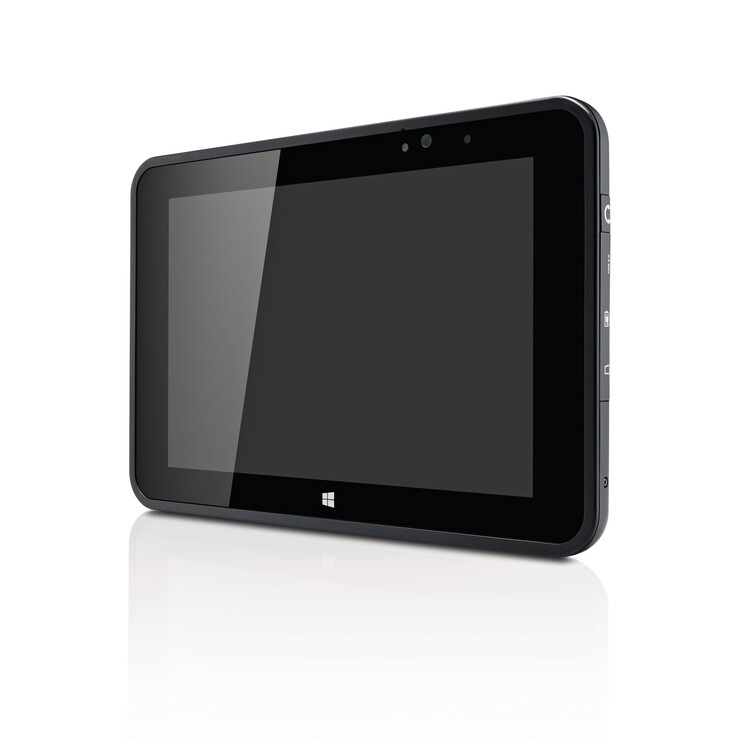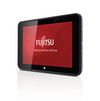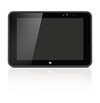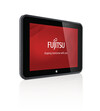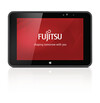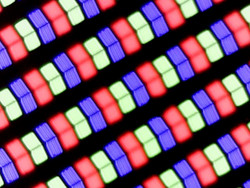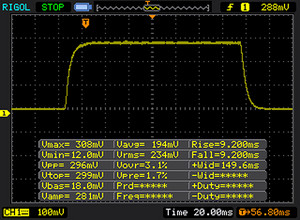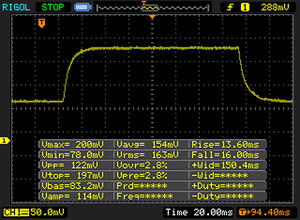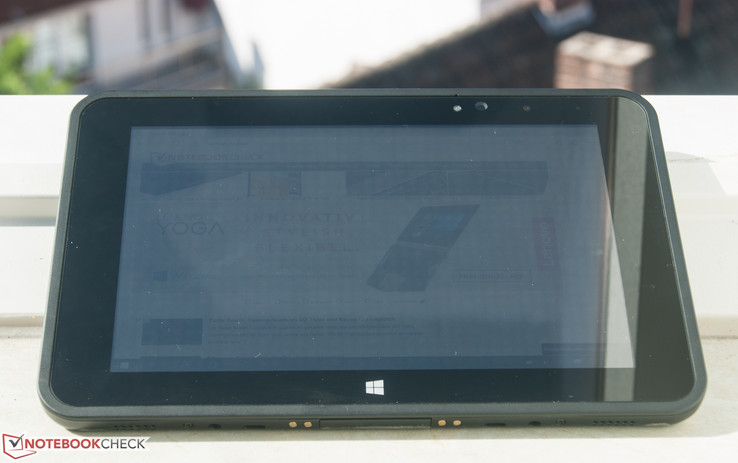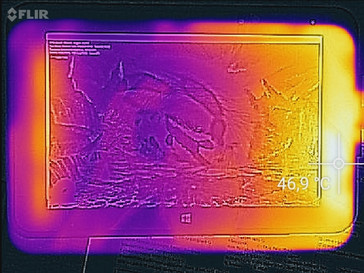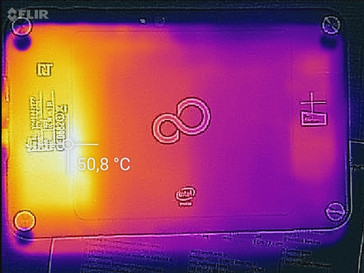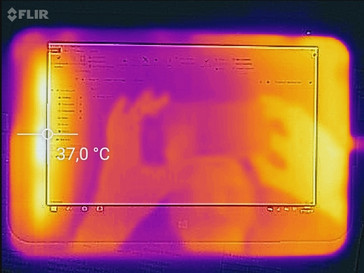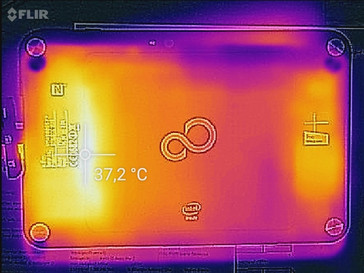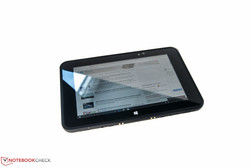Fujitsu Stylistic V535 (Z3795,128 GB, LTE) Tablet Review

For the original German review, see here.
The 8.3-inch Fujitsu Stylistic V535 tablet is designed for all kinds of industrial use. The business device for about 1300 Euros (~$1527) features an Intel Atom processor, 4 GB of RAM, and 128 GB of eMMC storage. Optionally, the tablet can be adapted to the work environment with many accessories.
The competition: Panasonic offers the Toughpad series as Windows and as Android variant. The Android version uses an Intel Celeron N2930 with Intel HD Graphics (Bay Trail), 2 GB of RAM and 32 GB of eMMC storage and it costs about 1700 Euros (~$1997). The Windows alternative for 1500 Euros (~$1762) comes with an Intel Core i5-4302Y, 4 GB of RAM and 128 GB SSD. The HP Pro Tablet 408 G1 and the Dell Venue 8 Pro are designed for less rough workplaces.
Case & Connectivity
The plain plastic case does not convey an industry product at first. However, the wide display frames and plastic covers on the interfaces suggest a robust business device. Overall, the build quality is satisfactory. Only the battery cover did not fit 100% accurately. Speaking of the battery: As already mentioned the battery sits beneath a cover on the rear side, which can be easily removed with a pry. The manufacturer has applied protection for potentially rougher industrial use. The tablet meets the MIL-STD 810G standard and is supposed to survive drops from up to 1.8 m (only with the optional rugged frame). In addition, the case complies with the IP65 standard, i.e. protection against dust penetration and splash water.
Optional accessories are listed on the product page.
| Product name | Price (incl. VAT MwSt) |
|---|---|
| Hand strap for STYLISTIC V535 | 53.40 Euro |
| Shoulder strap for STYLISTIC V535 | 57.00 Euro |
| Rugged Frame for STYLISTIC V535 | 355.70 Euro |
| Smart Shell with SmartCard for STYLISTIC V535 | ns |
| Mounting Kit for STYLISTIC V535 | 150.00 Euro |
| Universal Docking Cradle for STYLISTIC V535 | 413.80 Euro |
Fujitsu equips its industry tablet with a 4G/LTE module (optional), NFC, GPS, WLAN, and Bluetooth. The performance of the Wi-Fi module is alarmingly low. We only measured about 40 Mbit/s.
Connectivity
| Networking | |
| iperf3 transmit AX12 | |
| Microsoft Surface Pro (2017) i5 | |
| Lenovo ThinkPad X1 Tablet Gen 2 | |
| Fujitsu Stylistic V535 | |
| iperf3 receive AX12 | |
| Lenovo ThinkPad X1 Tablet Gen 2 | |
| Microsoft Surface Pro (2017) i5 | |
| Fujitsu Stylistic V535 | |
Input Devices
Since the manufacturer does not offer a pen, all inputs have to be done with the fingers via the touchscreen. The touch unit works satisfactorily and recognizes input in the corners and multi-touch gestures with ease. As already criticized in other reviews, the Windows system is hardly optimized for small touch displays. Those who do not want to deal with delicate inputs time and again and do not need a Windows system would be better off buying an Android device such as the Panasonic Toughpad.
Display
The used 8.3-inch display features a resolution of 1920x1200 pixels. Fujitsu decided to use a glossy IPS display in its industry tablet. The manufacturer specifies a brightness of 400 cd/m². Unfortunately, this brightness level is not reached in our test. We measured an average of 343 cd/m². Disappointing: The brightness falls to only 284 cd/m² on battery. This is too low; especially for an industry device which should also be suitable for use in bright outdoor environments. For example, the Panasonic Toughpad comes with a matte panel with an average brightness of 500 cd/m².
| |||||||||||||||||||||||||
Brightness Distribution: 83 %
Center on Battery: 284 cd/m²
Contrast: 717:1 (Black: 0.48 cd/m²)
ΔE ColorChecker Calman: 2.98 | ∀{0.5-29.43 Ø4.78}
ΔE Greyscale Calman: 3.26 | ∀{0.09-98 Ø5}
72% sRGB (Argyll 1.6.3 3D)
47% AdobeRGB 1998 (Argyll 1.6.3 3D)
51.4% AdobeRGB 1998 (Argyll 3D)
72.6% sRGB (Argyll 3D)
49.67% Display P3 (Argyll 3D)
Gamma: 2.42
CCT: 6106 K
| Fujitsu Stylistic V535 LG Philips LGD0000, , 1920x1080, 8.3" | Panasonic Toughpad FZ-B2 1280x800, 7" | HP Pro Tablet 408 G1 L3S97AA OspresCR PO, , 1280x800, 8" | Dell Venue 8 Pro 5855 MS 9001, , 1920x1200, 8" | Panasonic ToughPad FZ-M1 LFP14, , 1280x800, 7" | |
|---|---|---|---|---|---|
| Display | 12% | 3% | -13% | ||
| Display P3 Coverage (%) | 49.67 | 56.6 14% | 50.9 2% | 42.73 -14% | |
| sRGB Coverage (%) | 72.6 | 80 10% | 75.3 4% | 64.2 -12% | |
| AdobeRGB 1998 Coverage (%) | 51.4 | 58 13% | 52.7 3% | 44.17 -14% | |
| Response Times | -32% | 4% | |||
| Response Time Grey 50% / Grey 80% * (ms) | 29 ? | 26 ? 10% | 28 ? 3% | ||
| Response Time Black / White * (ms) | 19 ? | 33 ? -74% | 18 ? 5% | ||
| PWM Frequency (Hz) | 378 ? | ||||
| Screen | -72% | 9% | -28% | -16% | |
| Brightness middle (cd/m²) | 344 | 540 57% | 347 1% | 279 -19% | 561 63% |
| Brightness (cd/m²) | 310 | 498 61% | 333 7% | 255 -18% | 528 70% |
| Brightness Distribution (%) | 83 | 85 2% | 91 10% | 85 2% | 86 4% |
| Black Level * (cd/m²) | 0.48 | 0.32 33% | 0.11 77% | 0.2 58% | 0.77 -60% |
| Contrast (:1) | 717 | 1688 135% | 3155 340% | 1395 95% | 729 2% |
| Colorchecker dE 2000 * | 2.98 | 23.34 -683% | 5.45 -83% | 7.64 -156% | 5.55 -86% |
| Colorchecker dE 2000 max. * | 6.11 | 9.42 -54% | 15.3 -150% | ||
| Greyscale dE 2000 * | 3.26 | 6.82 -109% | 10.63 -226% | 6.22 -91% | 7.04 -116% |
| Gamma | 2.42 91% | 2.21 100% | 1.34 164% | 2.17 101% | 2.46 89% |
| CCT | 6106 106% | 6334 103% | 6404 101% | 6798 96% | 6323 103% |
| Color Space (Percent of AdobeRGB 1998) (%) | 47 | 52 11% | 49 4% | 41 -13% | |
| Color Space (Percent of sRGB) (%) | 72 | 80 11% | 71 -1% | 64 -11% | |
| Total Average (Program / Settings) | -72% /
-72% | -4% /
4% | -7% /
-17% | -15% /
-16% |
* ... smaller is better
Display Response Times
| ↔ Response Time Black to White | ||
|---|---|---|
| 19 ms ... rise ↗ and fall ↘ combined | ↗ 10 ms rise | |
| ↘ 9 ms fall | ||
| The screen shows good response rates in our tests, but may be too slow for competitive gamers. In comparison, all tested devices range from 0.1 (minimum) to 240 (maximum) ms. » 41 % of all devices are better. This means that the measured response time is similar to the average of all tested devices (20.2 ms). | ||
| ↔ Response Time 50% Grey to 80% Grey | ||
| 29 ms ... rise ↗ and fall ↘ combined | ↗ 13 ms rise | |
| ↘ 16 ms fall | ||
| The screen shows relatively slow response rates in our tests and may be too slow for gamers. In comparison, all tested devices range from 0.165 (minimum) to 636 (maximum) ms. » 38 % of all devices are better. This means that the measured response time is similar to the average of all tested devices (31.6 ms). | ||
Screen Flickering / PWM (Pulse-Width Modulation)
| Screen flickering / PWM not detected | ||
In comparison: 53 % of all tested devices do not use PWM to dim the display. If PWM was detected, an average of 8111 (minimum: 5 - maximum: 343500) Hz was measured. | ||
The CalMAN analysis reports a deltaE shift of about three. This result is normal for a high-end IPS panel. However, the color coverage, which is interesting for graphics professionals, is too low. The smaller sRGB color space is covered to 72%. The coverage of the big AdobeRGB space is only 47%.
As observed previously, the display brightness falls to about 284 cd/m² on battery. This is sufficient for using the tablet in the shade. However, it is not possible to use it in indirect or direct sun.
Performance
The Fujitsu Stylistic V535 Industrial is an 8.3-inch tablet for the business range. An Intel Bay Trail CPU with four cores and a base clock of 1.6 GHz works inside. In addition, it features 4 GB of RAM and a 128 GB storage device. The manufacturer charges about 1300 Euros (~$1527) for the bundle.
Processor
The core is an Intel Atom Z3795 from Intel's Bay Trail generation. The quad-core processor features a clock rate of 1590 to 2390 MHz. Because of its low TDP of less than 4 W, the CPU is especially suitable for mobile tablets. A special feature is 64-bit support. Hence, it can run all desktop programs.
In the Cinebench R15 multi-core test the result fluctuates heavily between 100 and 118 points. After several runs, the score falls to under 90. Thus, the performance heavily correlates with the temperature of the device.
See our special article for more comparisons and benchmarks.
System Performance
We were not always satisfied with the system performance of the small 8-inch device. Even after clicking the Windows start menu, there is a long delay. After uninstalling the preinstalled McAfee LiveSafe software, we could finally work with the test model. The PCMark 8 Home benchmark reports 1139 points, which is normal for the hardware. The HP Pro Tablet 408 G1 is about on par.
| PCMark 8 Home Score Accelerated v2 | 1139 points | |
| PCMark 8 Work Score Accelerated v2 | 1227 points | |
Help | ||
Storage Device
As is usual for the tablet range, eMMC storage is used. The storage device features lower transfer rates than the SSD variant. Our test model comes with a storage capacity of 128 GB. Fujitsu also offers a 64 GB variant for those who do not need that high a capacity.
| Fujitsu Stylistic V535 128 GB eMMC Flash | HP Pro Tablet 408 G1 L3S97AA 64 GB eMMC Flash | Dell Venue 8 Pro 5855 Hynix HCG8E 64 GB | Panasonic ToughPad FZ-M1 Samsung MZNTE128HMGR-000SO | |
|---|---|---|---|---|
| CrystalDiskMark 3.0 | -3% | -18% | 442% | |
| Read Seq (MB/s) | 164.3 | 114.8 -30% | 125.9 -23% | 503 206% |
| Write Seq (MB/s) | 61.1 | 55.3 -9% | 58.4 -4% | 138 126% |
| Read 512 (MB/s) | 156.3 | 118 -25% | 101.9 -35% | 422.7 170% |
| Write 512 (MB/s) | 42.27 | 63.5 50% | 43.9 4% | 137.8 226% |
| Read 4k (MB/s) | 15.75 | 17.4 10% | 13.6 -14% | 34.19 117% |
| Write 4k (MB/s) | 12.04 | 8.719 -28% | 8.2 -32% | 92.6 669% |
| Read 4k QD32 (MB/s) | 29.17 | 38.77 33% | 26.2 -10% | 364.4 1149% |
| Write 4k QD32 (MB/s) | 13.97 | 10.39 -26% | 10 -28% | 135.8 872% |
Graphics Card
An Intel HD Graphics (Bay Trail) is responsible for graphics output. The GPU features a core clock of 311 and 896 MHz and belongs to the low-end performance range. It performs averagely with a score of 191 in 3DMark 11. The Intel HD Graphics achieves between 122 to 237 points in 3DMark 11.
See our benchmark list of current notebook graphics cards for more benchmarks and comparisons with mobile graphics units.
| 3DMark 11 - 1280x720 Performance GPU | |
| Dell Venue 8 Pro 5855 | |
| HP ElitePad 1000 G2 | |
| Fujitsu Stylistic V535 | |
| Lenovo ThinkPad 10 | |
| HP Pro Tablet 408 G1 L3S97AA | |
| Dell Venue 11 Pro 5130-9356 | |
| 3DMark 11 Performance | 218 points | |
Help | ||
Gaming Performance
The gaming capabilities are very low. If you still want to play games on the small 8-inch device, you should stick to old games.
| low | med. | high | ultra | |
|---|---|---|---|---|
| BioShock Infinite (2013) | 8.4 | 3.5 |
Emissions and Energy
System Noise
Fujitsu decided to use passive cooling and a silent storage device. As a result, the test model does not emit noise at all.
Temperature
The temperature already increases to 33 °C in idle mode at an environment temperature of 23 °C. The reason is found quickly: The CPU load even exceeds 40% in idle mode, but we did not find out why exactly this happens. Under load, we measure high temperatures of about 45 °C. We had hoped for a better cooling strategy, especially since significantly higher environment temperatures are likely in industry use.
As soon as we run our stress test with Prime95 and FurMark, the CPU throttles to 600 MHz. After this test, the business tablet needs a while until full performance is available again. The 3DMark 11 results are about 10% lower after the stress test.
(±) The maximum temperature on the upper side is 42.5 °C / 109 F, compared to the average of 33.7 °C / 93 F, ranging from 20.7 to 53.2 °C for the class Tablet.
(±) The bottom heats up to a maximum of 44.9 °C / 113 F, compared to the average of 33.2 °C / 92 F
(+) In idle usage, the average temperature for the upper side is 30.3 °C / 87 F, compared to the device average of 30 °C / 86 F.
Speakers
The incorporated speakers should only be used for system sound. They simply sound too unbalanced for everything beyond that. Music sounds too high-tone heavy.
Fujitsu Stylistic V535 audio analysis
(±) | speaker loudness is average but good (72 dB)
Bass 100 - 315 Hz
(-) | nearly no bass - on average 18.8% lower than median
(+) | bass is linear (4.4% delta to prev. frequency)
Mids 400 - 2000 Hz
(±) | higher mids - on average 5.2% higher than median
(+) | mids are linear (5.8% delta to prev. frequency)
Highs 2 - 16 kHz
(+) | balanced highs - only 4.9% away from median
(±) | linearity of highs is average (7.7% delta to prev. frequency)
Overall 100 - 16.000 Hz
(±) | linearity of overall sound is average (21.2% difference to median)
Compared to same class
» 64% of all tested devices in this class were better, 4% similar, 32% worse
» The best had a delta of 7%, average was 20%, worst was 129%
Compared to all devices tested
» 58% of all tested devices were better, 7% similar, 35% worse
» The best had a delta of 4%, average was 24%, worst was 134%
Apple MacBook 12 (Early 2016) 1.1 GHz audio analysis
(+) | speakers can play relatively loud (83.6 dB)
Bass 100 - 315 Hz
(±) | reduced bass - on average 11.3% lower than median
(±) | linearity of bass is average (14.2% delta to prev. frequency)
Mids 400 - 2000 Hz
(+) | balanced mids - only 2.4% away from median
(+) | mids are linear (5.5% delta to prev. frequency)
Highs 2 - 16 kHz
(+) | balanced highs - only 2% away from median
(+) | highs are linear (4.5% delta to prev. frequency)
Overall 100 - 16.000 Hz
(+) | overall sound is linear (10.2% difference to median)
Compared to same class
» 7% of all tested devices in this class were better, 2% similar, 91% worse
» The best had a delta of 5%, average was 18%, worst was 53%
Compared to all devices tested
» 4% of all tested devices were better, 1% similar, 94% worse
» The best had a delta of 4%, average was 24%, worst was 134%
Frequency comparison (checkboxes select/deselectable!)
Power Consumption
The power consumption of the used components is on a normal low level at under 7.5 W. Under load there are two scenarios: Under average load, we measured a power consumption of 11.8 W. It falls to 8.9 W under maximum load due to CPU-throttling.
| Off / Standby | |
| Idle | |
| Load |
|
Key:
min: | |
Battery Life
The used two-cell lithium-polymer battery features a capacity of 16.48 Wh. The manufacturer specifies a maximum battery life of 6 h.
The Wi-Fi test gives a realistic battery life. We simulate web-surfing at a brightness of about 150 cd/m². The Fujitsu Stylistic V535 shuts down after just above 4 hours. The HP Pro Tablet 408 G1 performs better. At over 8 hours, it lasts a workday.
| Fujitsu Stylistic V535 Z3795, HD Graphics (Bay Trail), 17.7 Wh | Panasonic Toughpad FZ-B2 N2930, HD Graphics (Bay Trail), 24 Wh | HP Pro Tablet 408 G1 L3S97AA Z3736F, HD Graphics (Bay Trail), 18 Wh | Dell Venue 8 Pro 5855 Z8500, HD Graphics (Cherry Trail), 18.3 Wh | Panasonic ToughPad FZ-M1 4302Y, HD Graphics 4200, 22 Wh | |
|---|---|---|---|---|---|
| Battery Runtime | |||||
| WiFi Websurfing (h) | 4.2 | 5 19% | 8.2 95% | 5.3 26% | 4.1 -2% |
Pros
Cons
Verdict
A tablet for high industrial requirements. The Fujitsu Tablet Stylistic V535 targets those who need a reliable tablet for rough environments. In order to achieve this goal, the 8.3-inch tablet complies with several standards such as the MIL STD 810 test. Moreover, the manufacturer offers accessories for various usage scenarios, for example a docking solution, a rugged frame, and straps. While the test model offers several communication options, Wi-Fi communication is extremely slow. Unfortunately, the display also falls behind our expectations. It cannot reach the specified brightness of 400 cd/m² by far. Since an industry device will also be used outdoors, the low brightness might be a reason not to buy this tablet.
We are also not satisfied with the performance: It appears that the test model is often overextended. Long delays and stuttering are not infrequent. The fully fledged Windows system appears to be too much for the Stylistic. This is also reflected by the temperature development. A temperature increase can even be observed in idle mode at an environment temperature of 23 °C. The easily replaceable battery and the battery life of above four hours are advantages.
The Stylistic V535 is well suitable for those who are looking for an industry tablet with many communication features and Windows operating system.
Nevertheless, it is worth considering the competition: The Panasonic Toughpad features a brighter and matte display and Android as operating system.
Fujitsu Stylistic V535
- 07/24/2017 v6 (old)
Nino Ricchizzi




